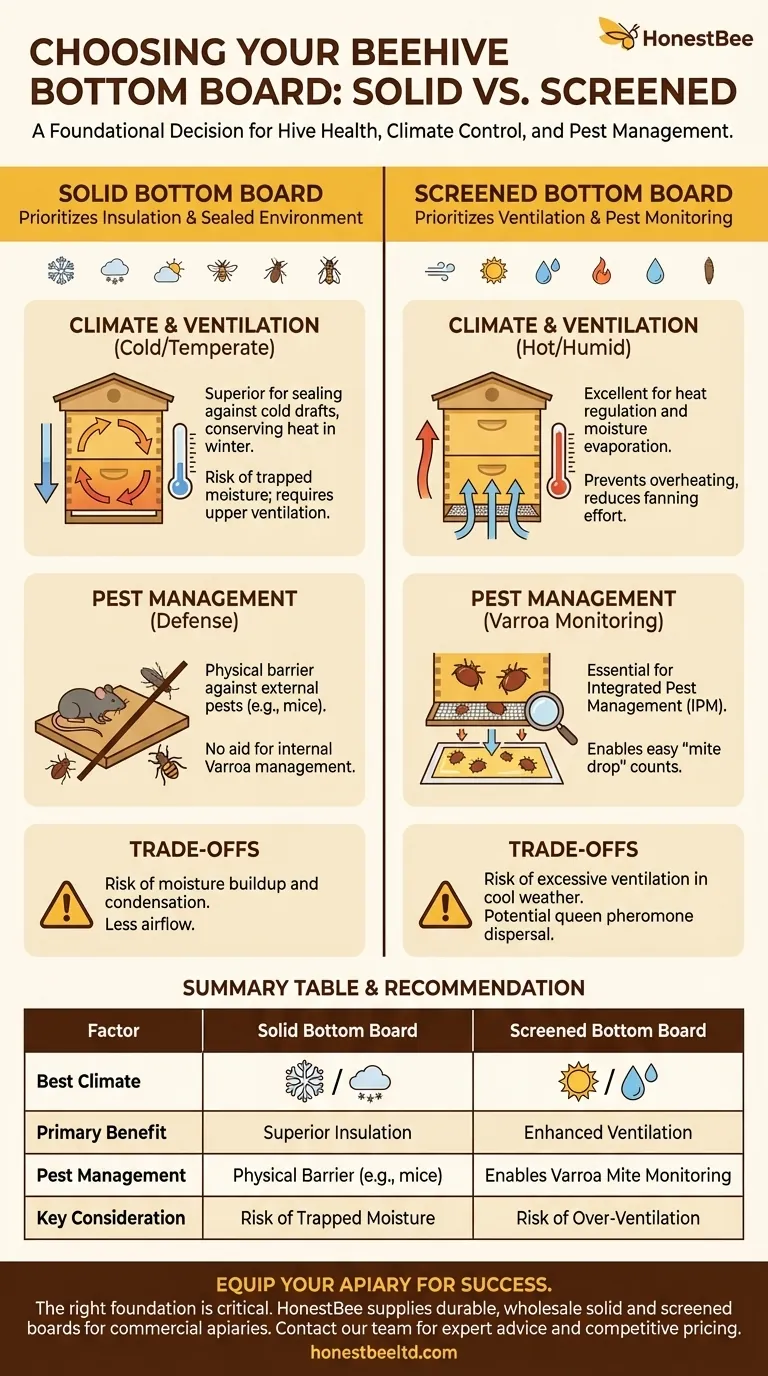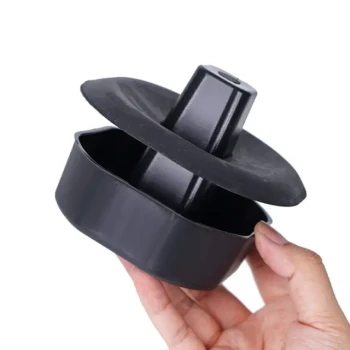The choice between a solid and screened bottom board is a foundational decision in beekeeping. This decision directly impacts your hive's temperature regulation, moisture control, and your ability to manage pests. The primary factors guiding your choice are your local climate, your strategy for controlling Varroa mites, and the specific ventilation needs of your colony.
Your decision is fundamentally a trade-off between insulation and active management. Solid bottom boards prioritize a sealed, insulated environment, while screened bottom boards prioritize ventilation and provide a crucial tool for pest monitoring.

The Role of Climate and Ventilation
The most significant factor in your decision is the environment where your bees live. The bottom board directly controls how much air flows through the hive from below.
For Hot and Humid Environments
In regions with high heat and humidity, a screened bottom board is almost always the superior choice. The constant airflow helps the colony regulate its internal temperature more efficiently.
This ventilation is critical for preventing the bees from overheating and reduces the energy they must expend on fanning to cool the hive. It also helps evaporate excess moisture, reducing the risk of mold and mildew.
For Cold and Temperate Climates
In colder climates, a solid bottom board offers a clear advantage by sealing the hive from cold drafts. This helps the colony conserve heat and energy during the winter cluster.
Many beekeepers in these regions find that solid boards can contribute to an earlier brood buildup in the spring, as the hive warms more quickly. However, a screened bottom board can still be used if it is closed off with its removable insert or "sticky board" during the coldest months, effectively turning it into a solid board.
A Critical Tool for Pest Management
Your approach to managing Varroa mites, one of the most serious threats to honeybees, should heavily influence your choice.
Monitoring Varroa Mites with Screened Boards
A screened bottom board is an essential component of an Integrated Pest Management (IPM) strategy. It allows you to perform "mite drop" counts easily.
By sliding a coated "sticky board" under the screen for a set period, you can count the mites that naturally fall off the bees. This data provides a reliable estimate of the mite population within the hive, allowing you to treat them only when necessary.
Solid Boards and Pest Defense
A solid bottom board provides a physical barrier that prevents pests like mice or other insects from entering the hive from below.
However, it offers no assistance in managing internal pests like Varroa mites. Any mites that fall off the bees simply land on the bottom board and can climb back onto another bee.
Understanding the Trade-offs
Neither option is perfect for all situations. Understanding their respective drawbacks is key to making an informed decision.
The Risk of Over-Ventilation
The primary downside of a screened bottom board is the potential for excessive ventilation in cool weather. This can create a draft that makes it harder for the colony to maintain its crucial brood nest temperature.
Some beekeepers also suggest that the constant airflow can disperse the queen's pheromones more quickly, which could theoretically impact colony cohesion.
The Problem of Trapped Moisture
The main weakness of a solid bottom board is its tendency to trap moisture. As the bees respire, they release warm, moist air that can condense on cold inner surfaces, dripping back down on the cluster.
This condensation can be harmful or even fatal to the colony during winter. Proper upper ventilation becomes absolutely critical when using a solid bottom board to allow this moisture to escape.
Making the Right Choice for Your Hive
Selecting the right bottom board is about aligning the equipment with your climate and your management style.
- If your primary focus is overwintering in a cold climate: A solid bottom board offers superior insulation and is a simple, effective choice.
- If your primary focus is active Varroa mite management: A screened bottom board is an indispensable tool for monitoring mite levels without disturbing the colony.
- If your primary focus is beekeeping in a hot climate or you want maximum flexibility: A screened bottom board with a removable insert provides ventilation in the summer and can be closed for insulation in the winter.
Ultimately, understanding these principles allows you to select the right foundation for a thriving, healthy colony.
Summary Table:
| Factor | Solid Bottom Board | Screened Bottom Board |
|---|---|---|
| Best Climate | Cold, Temperate | Hot, Humid |
| Primary Benefit | Superior Insulation, Draft Protection | Enhanced Ventilation, Cooling |
| Pest Management | Physical Barrier (e.g., vs. mice) | Enables Varroa Mite Monitoring (Mite Drop Counts) |
| Key Consideration | Risk of Trapped Moisture | Risk of Over-Ventilation in Cool Weather |
Equip your apiary with the right foundation for success. The choice of bottom board is critical for hive health and productivity. At HONESTBEE, we supply durable, precision-made solid and screened bottom boards designed for the demands of commercial apiaries and beekeeping equipment distributors. Our wholesale-focused operations ensure you get the reliable equipment you need to build thriving colonies. Let's discuss the best solution for your operation—contact our team today for expert advice and competitive pricing.
Visual Guide

Related Products
- Langstroth Solid Bottom Board for Beekeeping
- Langstroth Screen Bottom Board for Beekeeping Wholesale
- Solid Bottom Board Australian Pine Wood Langstroth Bottom Board for Wholesale
- Australian Pine Wood Langstroth Screen Bottom Board for Wholesale
- HONESTBEE Professional Long Handled Hive Tool with Precision Cutting Blade
People Also Ask
- How does climate affect the choice of bottom board for a beehive? A Guide to Screened vs. Solid Boards
- What are the characteristics of a solid bottom board? A Guide to Hive Foundation & Climate Control
- What is the recommendation for bottom boards in top bar hives? Choose the Right Foundation for Your Climate
- How do honeybees adapt to different bottom board types in terms of temperature regulation? Optimize Your Hive Climate
- What is the suggested approach for choosing hive boards if you have only 1 or 2 hives? Test Both Types to Find Your Perfect Fit.



















